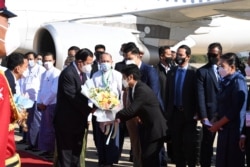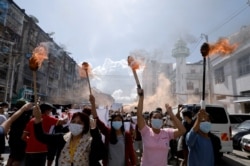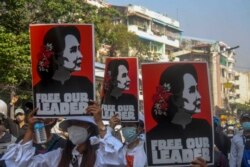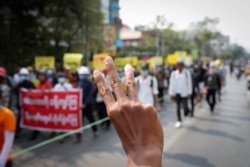On January 7, Cambodian Prime Minister Hun Sen arrived in Myanmar for a two-day visit, during which he met the country’s military ruler, Min Aung Hlaing.
It was the first visit to Myanmar by a foreign leader since the February 2021 military coup that ousted the country’s elected government.
The visit carried additional weight given that in October, Cambodia officially assumed the chairmanship of the Association of Southeast Asian Nations (ASEAN). The group, which includes Cambodia and Myanmar, has spearheaded efforts to end the bloodshed after the coup.
Also in October, Myanmar was excluded from an ASEAN summit for failing to enact the Five-Point Consensus, ASEAN’s plan to end violence in the country.
Hun Sen framed his trip to Myanmar as part of ASEAN’s efforts to bring peace. But the visit sparked protests in Myanmar, and bombs were detonated near Cambodia’s embassy in the capital, Yangon.
Critics charged Hun Sen with giving legitimacy to Myanmar’s military rulers, an accusation he denied.
The Fresh News service, which is aligned with Cambodia’s government, reported that Hun Sen “did not care about” those in Myanmar “opposing his efforts to resolve the Myanmar crisis,” and that “his mission is to assist Myanmar escape civil war.”
"I did not blame some Burmese people who burned and stepped on my portraits, but they need to know that their lives will be rescued from wars thanks to ASEAN roles, which includes my visit to Myanmar,” Fresh News quoted Hun Sen as saying.
“The agreement to declare ceasefire by the Myanmar leaders is an important step [to securing peace].”
Fresh News added that Hun Sen urged “all parties in Myanmar to end the violence” so that Myanmar could avoid the decades of civil war that Cambodia experienced.
However, there is little evidence that Hun Sen’s visit or Myanmar’s “cease-fire” will actually foster peace. It is also misleading to frame Myanmar’s violence as a civil war between opposing groups of citizens.
Rather, the popular uprising against Myanmar’s military rulers is a direct result of the ouster of the country’s elected government and the military’s willingness to use force to maintain undemocratic rule.
Myanmar’s military announced a five-month cease-fire with Ethnic Armed Organizations (EAOs) in September 2021. During Hun Sen’s visit, the military announced the cease-fire would be extended until the end of the year.
EAOs, which come from Myanmar's varied non-ethnic Burmese communities, control as much as a third of Myanmar's territory. Broadly, they have fought for independence, greater autonomy, control of resources in their ancestral homelands and/or greater representation/rights in Myanmar's civic and political life.
But analysts believe the decision to maintain the cease-fire with the EAOs, some of which have been struggling for independence for decades, is intended “to take pressure off the military,” the Voice of America’s sister organization Radio Free Asia reported.
That, analysts argue, will allow Myanmar’s military to wipe out the People’s Defense Force (PDF) militias, which are the armed wing of Myanmar’s government in exile.
There are dozens of EAOs in Myanmar, but only 10 have signed off on the cease-fire.
The cease-fire was announced weeks after Myanmar’s shadow National Unity Government (NUG) called for a popular uprising. Despite the cease-fire, Myanmar’s military has ratcheted up its violence.
Last month, a senior United Nations official expressed horror over a December 24 attack against civilians in Kayah State (also called Karen State) that left at least 35 dead, including children and humanitarian workers.
Meanwhile, airstrikes in Kayah State sent hundreds fleeing into neighboring Thailand, Reuters reported.
Those and other attacks prompted the United Nations’ new special envoy to Myanmar to express her deep concern over escalating violence in the country.
According to Assistance Association of Political Prisoners, a Myanmar nongovernmental group, 1,461 people have been killed by the military since the coup. State-backed torture, disappearances, extrajudicial killings and massacres of those opposed to military rule have continued unabated.
An Associated Press investigation in December 2021 found that Myanmar’s military is relying on a strategy of “massacres and scorched-earth tactics — such as the razing of entire villages” to violently suppress popular opposition.
As chair of ASEAN, Hun Sen sidestepped a key sticking point that led to Myanmar’s exclusion from the October ASEAN summit — the military junta's refusal to allow the ASEAN special envoy’s team to meet with “all parties concerned” in the country.
Hun Sen did not seek to meet Myanmar’s ousted civilian leader Aung San Suu Kyi, who was hit with an additional four-year prison sentence on January 10, just days after Hun Sen’s visit.
Suu Kyi was sentenced in December to four years for incitement and breaking coronavirus restrictions. Myanmar’s military ruler Min Aung Hlaing later reduced that sentence to two years.
Hun Sen framed his lack of engagement with the military’s opposition as a way to avoid setting preconditions for talks.
Others argue that Hun Sen, who has ruled Cambodia for decades and turned his own country into a de facto one-party state, is bolstering his authoritarian ally.
Charles Santiago, chairman of the ASEAN Parliamentarians for Human Rights (APHR), accused Hun Sen of “cowboy diplomacy” and “sabotaging” ASEAN’s position in the Five-Point Consensus.
“The joint statement released by the Cambodian Prime Minister with the leader of the illegal junta, Senior General Min Aung Hlaing, is a misguided and dangerous attempt to deceptively portray a breakthrough, when in fact, his unilateral actions have dramatically weakened ASEAN’s collective leverage to solve the Myanmar crisis,” Santiago said in a prepared statement.
“It is a brazen attempt by these two coup leaders to hijack ASEAN for their own authoritarian purposes, undermining the Myanmar people's fight for democracy and human rights.”
Santiago called on the other eight ASEAN members “to clarify their position with a statement supporting the return to a democratic process in Myanmar,” so as not to de facto collude “with Hun Sen’s apparent intent to dismantle ASEAN's leverage with the junta.”
Ong Keng Yong, a Singaporean diplomat and former ASEAN secretary-general, likewise saw little merit in Hun Sen’s visit, framing it as an attempt to legitimize Myanmar’s military rulers.
“The statement they issued is full of words but nothing substantive to resolve the current political crisis regarding Myanmar," he said. “Cambodia's strategy for the visit by Hun Sen is getting a fig leaf to allow Phnom Penh to invite Myanmar's foreign minister to attend ASEAN's foreign minister's retreat.”
Further underlining perceptions that Hun Sen is working to bolster Myanmar’s military rulers, Fresh News reported that, during Hun Sen’s visit, Min Aung Hlaing asked him to be his “Godbrother.”
Meanwhile, Zaw Tuseng, founder and president of the Myanmar Policy Initiative (MPI), argues that the current conflict in Myanmar is not a conventional war, civil war or insurgency, but “a national uprising.”
“It is rare to find a country where the population has so conclusively turned against one institution,” he wrote in an August 2021 op-ed. “The biggest threat to the military is not another standing army; it is a public that is united in seeing it as the problem.”
The overwhelming victory of Suu Kyi’s National League for Democracy over the military-aligned Union Solidarity and Development Party in Myanmar’s 2020 general election attests to this.
Myanmar’s military harshly cracked down on the mass protests, strikes and other forms of civil disobedience sparked by its coup. That, in turn, sparked popular armed resistance.









